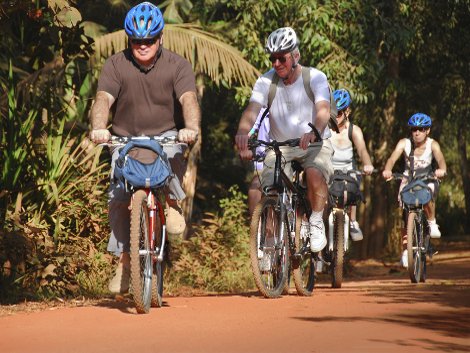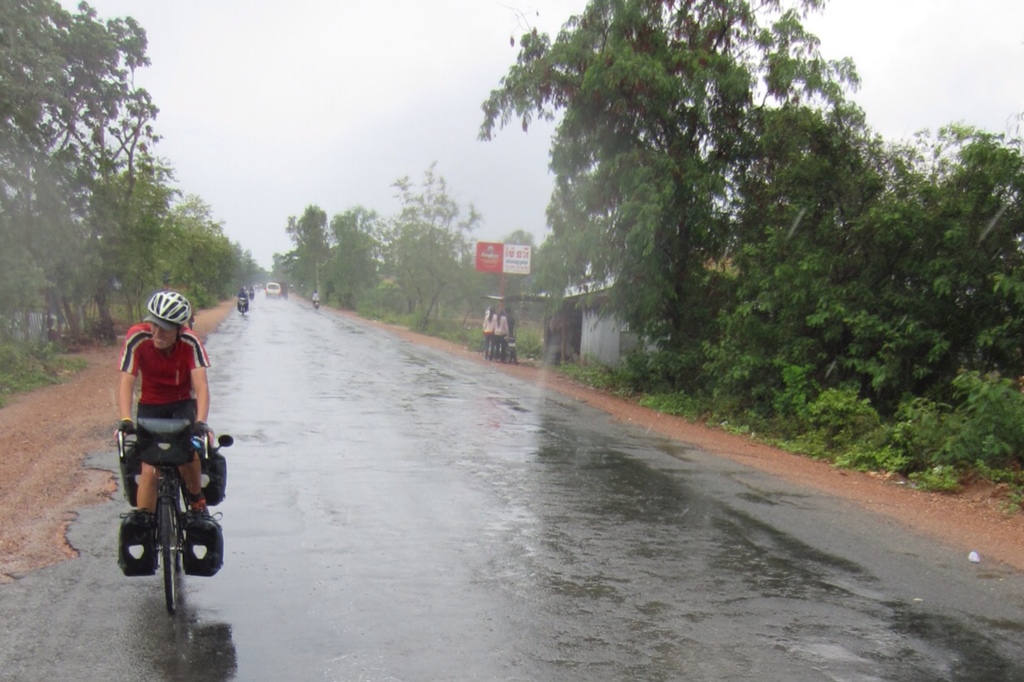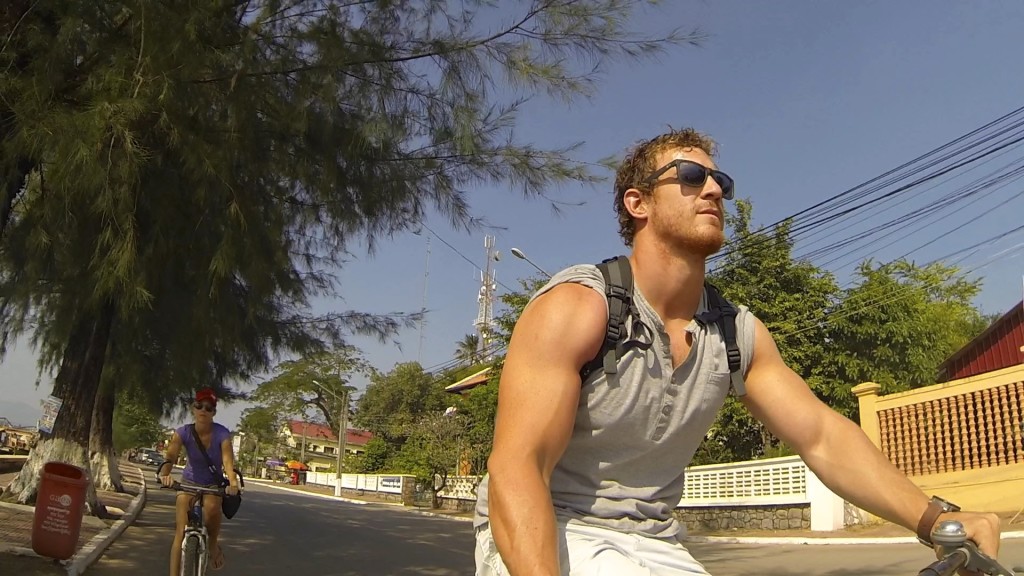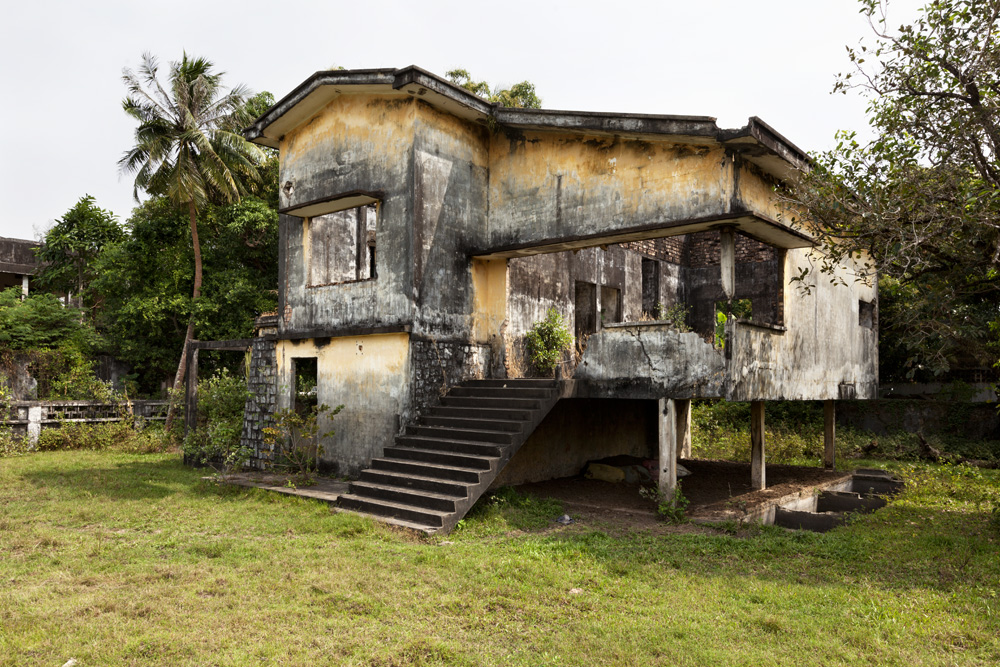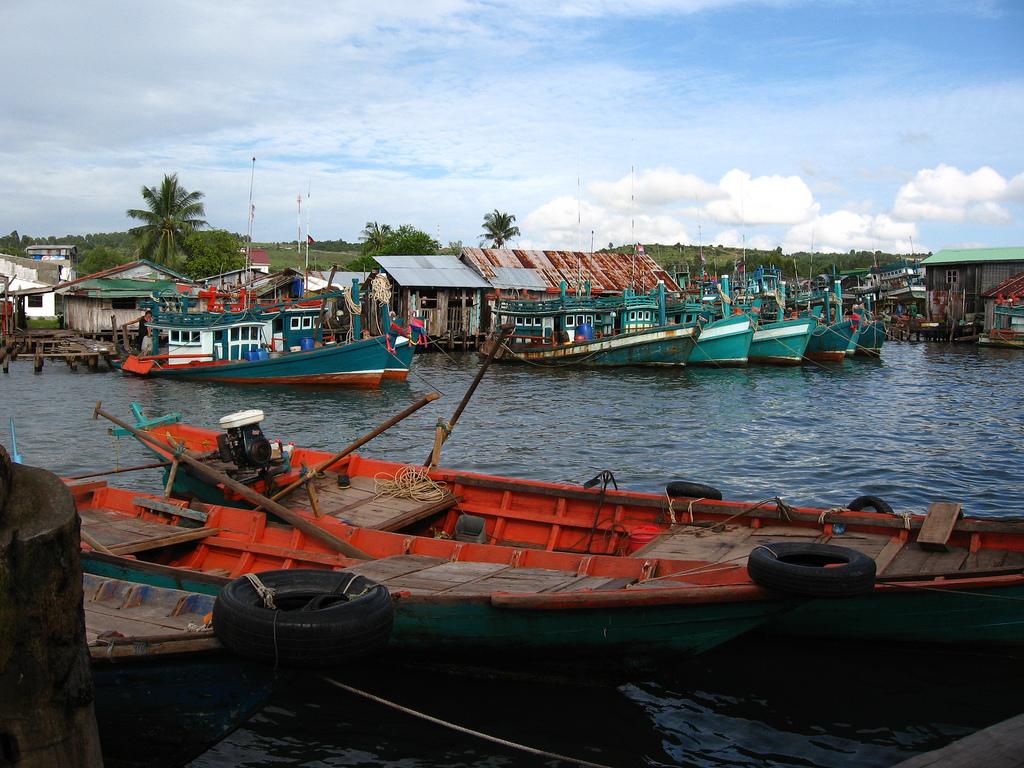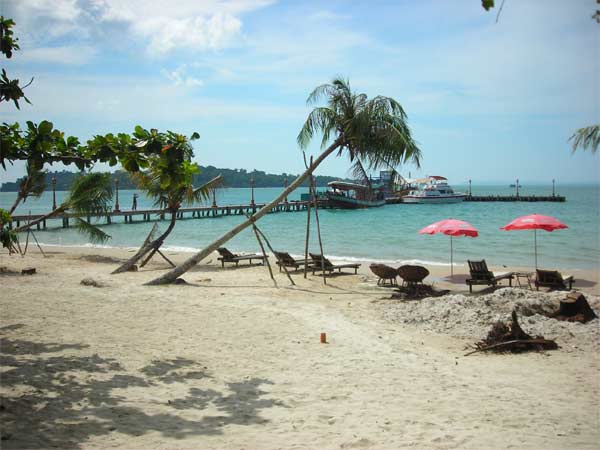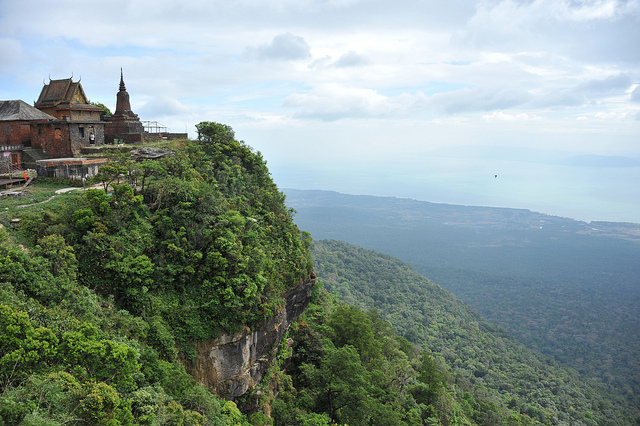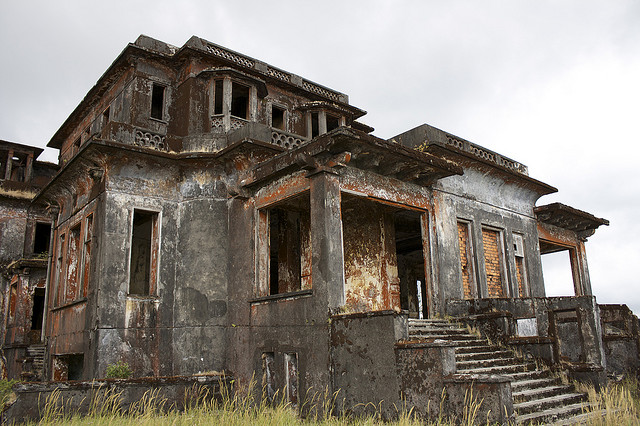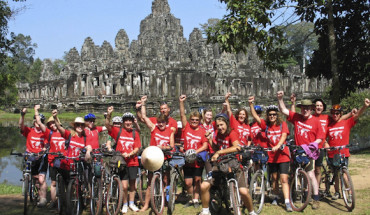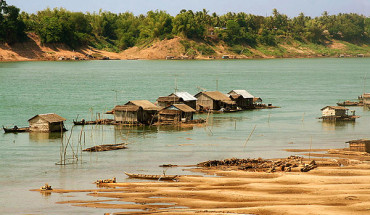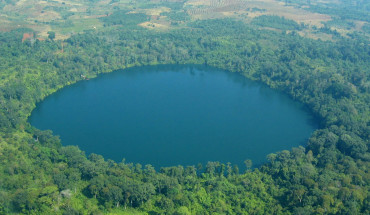This ride is the perfect introduction to Cambodia’s undiscovered coastline. Destination ihanoukville is the country’s premier beach resort, a town of endless tropical beaches and unexplored islands. Along the way from Phnom Penh are the pre-Angkorian ruins of the Chenla empire, found near Takeo, the faded colonial grandeur of the beachside town of Kep and breathtaking views from the hill station of Bokor.
The ride can be accomplished in as little as four days for those in a hurry, but it is best to take a week as this allows time for saddle breaks at Takeo and Kep, as well as a chance to tackle the tough climb to Bokor. The ride from
Kampot to Sihanoukville is long and grueling on a hot day. For those that want to complete the loop, it is quite straightforward to cycle from Sihanoukville back to the capital on Hwy 4, although reckon on two to three days and a night in a pagoda.
History
The region of Angkor Borei in modern-day Takeo province was home to the Chenla kingdom, a forerunner of the mighty Angkor Empire. Some ruined Hindu temples remain, including Phnom Da, about 20km south-east of Takeo town. However, during the Angkor period this southern portion of Cambodia was almost wholly ignored while rulers concentrated on building the magnificent temples that dot the north- west. Tonle Bati is one of the few Angkorera monuments in this area.
During more recent times, the area was engulfed in heavy fighting as both Takeo and Kampot are important agricultural contributors to the Cambodian diet. Large parts of Kampot fell under Khmer Rouge control as early as 1970 and the last rebels only came over to. the government side as late as 1995.
Sihanoukville was founded in 1959 as a seaport to avoid Phnom Penh’s dependence on Vietnam and the Mekong River. Many supplies made it to the Vietnamese communists through this port during the 1960s. After the overthrow of Sihanouk in 1970, US supplies for the Cambodian government came in through here. In May 1975 it was heavily bombed by US warplanes in the last act of the Vietnam War, a retaliatory attack in response to the capture of servicemen off the coast of Cambodia.
Planning the trip
When to Ride
Most of this route follows surfaced roads so it can be undertaken at any time of year. However, there is an unholy unsurpassed section between Kampot and Sihanoukville which is extremely hard-going after rain.
What to Bring
There is a good selection of accommodation on this ride. Carry a mosquito net and warm clothing if planning to take on Bokor.
The Ride
Day 1: Phnom Penh to Takeo
4-5 hours, 73.7km
This is a fairly smooth run along National Hwy 2, a well-surfaced road that sees little traffic. Phnom Penh sprawls along the banks of the Tonle Bassac and it takes a fair amount of pedaling to leave the city limits. The capital blends seamlessly into the town of Takhmau (8.1 km), where Prime Minister Hun Sen has a heavily guarded home compound. Love him or hate him, at least his presence here has ensured the first part of the ride is on an excellent surface. Takhmau has a lively provincial market and is a good place for supplies.
After Takhmau, there are some colorful nurseries where many of the ornate plants and flowers on show in Phnom Penh are from. Cambodia soon shows its true colors as a rural country of farming communities and simple life. There are no towns along the way, just a series of small villages strung out along the highway.
The Angkorian-era temple of Tonle Bati is a possible side trip at 30.5km. The temple is hardly dramatic for those who have visited Angkor, but for the uninitiated it makes a nice introduction to the ancient architecture of Cambodia. Entry costs fees and a selection of over-priced food is available nearby bring a picnic.
Phnom Tamao (36.2km) is an animal rehabilitation centre and zoo. The side trip to Phnom Chisor, an ancient temple mountain with a modern pagoda at its summit, might be too much for many in the heat of the day as there are several hundred steps to climb.
On the last stage of the route the road tunnels through scenes of flourishing life, both people and plants. Even if the dry season has browned the landscape, it once again bursts into co lour near Takeo. This area spends much of the year under water and the rice cannot be planted until the waters recede. It’s normal to feel a sense of deja vu at the day’s end, as Takeo’s Independence Monument is a copy of the larger one in Phnom Penh.
Takeo
This small provincial capital would see few visitors were it not for the nearby remains of one of Cambodia’s earliest civilizations. The town has some pleasant, if unexceptional, colonial architecture, but the main attractions lie in the area known as Angkor Borei. There are no banks to speak of.
Things to See & Do The massive building sitting on an island in the lake was built as a residence for notorious Khmer Rouge military commander Ta Mok, who was born in this area. Rumour has it he had builders executed upon completion of each floor so that he alone knew the floor layout. It became a hotel in the 1980s and is today disused. Ta Mok, meanwhile, is imprisoned in Phnom Penh awaiting trial for crimes against humanity for his role in the 1970s genocide.
It is worth spending an extra day to charter a speedboat and visit the remains of the pre-Angkorian Chenla civilization at Angkor Borei. Here a small museum dedicated to the Chenla period is housed in an old administrative building. Boats also go a few kilometers further to the hill of Phnom Oa, upon the summit of which is a small, 6th-century late rite temple. Boats can be chartered for about US$IS for the round trip and the fast ride is pretty exhilarating.
Day 2: Takeo to Kampot
5-6 hours, 85km
This journey cuts west to National Hwy 3, a road in reasonable condition for most of its length. The ride leaves Takeo on a small branch road that meets Hwy 3 at the small town of Angk Tasaom (12.4km). This town is a popular stop for buses and taxis so has some pretty good restaurants for a late breakfast.
The main road to Kampot is well populated with a sprinkling of small villages so water and basic foodstuffs are never far away. The province of Kampot is breached after 33.Skm and a couple of hundred meters beyond are the remains of the Royal University of Takeo-Kampot, one of Cambodia’s pre-Revolutionary learning institutions that didn’t survive the class fury of the Khmer Rouge.
The small town of Chhuk (44.7km) is a useful place to grab a meal as there is a small, lively market and a couple of basic restaurants. The second half of the ride winds through pretty countryside as hill ranges come in and out of sight, although fortunately never close enough to tax the legs. Around 10km before Kampot, the massive frame of Phnom Bokor imposes it- self on the horizon.
Kampot
Kampot tasted glory in the first half of the 20th century as Cambodia’s main port and the signs of its former grandeur are visible all over the town. It lost its position as port to Sihanoukville several decades ago and has worn a cloak of dereliction ever since. It is, however, a graceful town, nestled on a river- bank under the shadow of Phnom Bokor. Durian haters beware: Kampot is famous for
the pungent fruit that foreigners love to hate.
Information There are no banks for changing money, but US dollars are accepted around town. The best hunting ground for bicycle-repair shops is around the market, just off Hwy 3 on the run into town. The post office is just south of the bridge.
Things to See & Do An example of the town’s handsome colonial architecture is the Governor’s Residence, south along the river.
About 8km north of town, on the west bank of the river, is Tuk Chhou, an inconsequential set of rapids that sends Khmers all doe-eyed about nothing. There is also a small zoo here.
It is possible to arrange boat trips on the river. Contact the Marco Polo Restaurant or find a local boat owner yourself.
Day 3: Kep Circuit
3-4 hours, 50km
This is a gentle ride back in time to a long- lost Cambodia of fading colonial grandeur at the former beachside retreat of Kep sur Mer, now undergoing a tentative resurgence. This loop route returns to Kampot so there is no need to load up all the gear. However, for those intrigued by Kep’s history and decay, it can make an interesting place to spend the night.
The road is in reasonable condition for most of the way, with the exception of a short section east of Kep. Very few vehicles come this way unless it is the weekend, in which case the well-to-do Phnom Penh-set descend in droves, hogging the road in their 4WDs.
Leaving Kampot, endless salt beds divide the road and the coast: Kampot is renowned for its salt and pepper production. Kampot pepper was once regarded as some of the best in the world and no self-respecting Parisian restaurant would be without it on the dining table. After years of neglect during the war, investors are once more turning their eyes to Kampot’s pepper groves.
There are several small hills to the left of the highway, one of them the sacred mountain Phnom Sesia. The side trip there is best saved for the return journey when the cool of the caves is a good antidote to sweating in the sun. There is an active monastery at the bottom of the hill and several large caves and shrines dotted around.
A few kilometers after branching right at the statue of the white horse (14.8km) – the unofficial gateway to Kep – the first abandoned villas of this once-elite resort come into view. The road hugs the coast, passing a couple of small guesthouses and a clutter of food stalls serving fresh crab and squid. The main beach is another good spot for dining; agree on a price before eating and ensure the ‘fresh’ seafood is indeed freshly cooked before your eyes.
Kep sur Mer (23.4km) was founded in 1908 by the French as a seaside resort for the colonial elite. After independence, it found equal favor among the Cambodian elite and continued to prosper, known simply as Kep, until the advent of the Khmer Rouge. During the Khmer Rouge reign, it is likely the villas were used by the leaders for holidays. Locals say most of the buildings were stripped of fittings during the 1979, 80 famine and sold to the Vietnamese, so certain parts of Ha Tien now look like Kep did 25 years ago!
The main things to do in Kep are relaxing on the beach or exploring the empty buildings. Fishermen can be collared into taking people to the attractive offshore is- lands, including Koh Tonsay (Rabbit Island) with its white sand beaches.
The pick of Kep’s guesthouses are the Seaside Guesthouse, a short distance from the beach; Le But du Soleil on the hill above the beach; and Phoung Bon Guest house. Kep has many footstalls that serve fresh seafood by the beach: many pack up and disappear by the evening, so order in advance if you don’t want to go hungry at night.
The mermaid statue (23.9km) is a popular Kep landmark and many Khmers like to have a photo, or 10, taken nearby.
On the return, make time to do the Phnom Sesia side trip (36.5km).
Day 4: Kampot to Sihanoukville
7-8 hours, 100.9km
The ride from Kampot to Sihanoukville is one of the most attractive in Cambodia, with picturesque fishing villages at regular intervals and the huge Phnom Bokor towering over the road to the north. However, less stunning is the condition of the road for much of the mid-section. This is certainly one of the longest day’s riding recommended in Cambodia, but it is possible to link up with a bus or pick-up for the last stage if you are running late or tiring.
At 7.7km those who can’t resist a challenge can turn-off to Bokor National Park; see the ‘Bokor Hardcore Adventure’ boxed text below. The road falls under the shadow of Bokor for another 40km while winding its way through shrimp hatcheries, fishing fleets and small communities. Locals dry the shrimps on the roadside throughout the dry season – this could be a hazard should one run over them, as the villagers might not be too happy. A good village for a break is Prey Ampul (31.8km) as it has a market, several refreshment stalls and a large fishing fleet moored in the estuary. Carry plenty of water from here as there are few settlements in the next 21 km (and no tarmac!).
The section of bad road was reasonable in 1998, bearable in 1999, decidedly unbearable in 2000, and plain daft by 200 I, so must be due for a facelift soon. However, even the worst stretches are manageable on a bicycle, as there are some easy trails to follow through the general mess. This is a very difficult road to travel in the wet season as some of the holes are like bomb craters and floods are regular. Fortunately this glimpse of perjury lasts just 21 km. The end is in sight soon after the long, rattling bridge, although the improved surface comes at a price, which is a great deal more traffic.
National Hwy 4 is one of the best roads in Cambodia, with a broad shoulder for bicycles and motorbikes. Veal Rinh (53.4km) is the gateway to this road and, as a significant- sized town, has a good market and lots of small restaurants. From here to Sihanoukville it’s almost 501em, including several significant (by Cambodian standards) climbs and descents. The road traces the perimeter of Ream National Park, one of the easiest protected areas to visit in Cambodia. Sihanoukville is very spread-out: from the welcome sign to the end of the ride is almost 10km.
Sihanoukville (Kompong Som)
Cambodia’s leading beach resort is ringed by empty, gleamingly white, sand beaches and deserted tropical islands. Founded in 1959, it was named in honour of the country’s mercurial monarch, King Sihanouk. After his overthrow by Lon Nol in March 1970, the name was changed to Kompong Som many Khmers use both names even today.
The town is extremely nondescript, but is increasingly popular with backpackers as the gateway to a cheap and fast route in and out of Thailand. It may not be Asia’s finest beach town, but it also isn’t Asia’s busiest seaside town, which adds to its appeal. It is a great town for cyclists, as few places are within walking distance of each other.
Information Several banks in town can change money, but Canadia Bank and CCB have the most extensive services. The easiest place to find bicycle repairers is around Psar Leu (central market).
Things to See & Do Sihanoukville has four main beaches: Victory Beach is the backpacker end of town, and is less attractive than the others due to the backdrop of the port; Independence Beach is quiet and the least popular; Sokha Beach is the quintessential tropical beach, but looks like being swallowed up by a resort in the near future; and Ochheuteal Beach is a good long stretch of sand where many of the more up market hotels and restaurants are found.
There are also many beautiful islands off the coast and many of the guesthouses and restaurants arrange boat trips.
Diving can be arranged but there is not quite the wealth of marine life as in Thailand or Indonesia. Contact Chez Claude for details.
There is also the option of a boat trip through Ream National Park about 15km south-east of Sihanoukvilie. As long as you can muster a group, park rangers are happy to escort people.
About 151km out of town is Kbal Chhay, a beautiful waterfall that has recently become a very popular excursion for Khmers. It is possible to bathe beneath the falls; cycling there takes little more than an hour.
Bokor hardcore Adventure
Bokor National Park encompasses one of South-East Asia’s most important tropical forests. There was talk of making the whole area a Unesco World Heritage Site but, sadly, the loggers have done significant damage throughout the park in the past few years. However, it remains an area of stunning beauty and the massive escarpment offers some of Cambodia’s best coastal views.
A number of shy mammals live within the park, including elephant, leopard and tiger. They are extremely difficult to spot, although rangers may be able to help arrange a night trek to view elephants at their watering holes.
Bokor Hill Station – once a popular retreat for the French, then Cambodian elite – is today a ghost town of windswept abandoned buildings where lichen obscured paint long ago. The area was abandoned after fighting between Lon Nol’s forces and the Khmer Rouge in the early 1970s.
It isn’t hard to imagine the grandeur of the place during its heyday, and the views from the Bokor Palace Hotel are not diminished by the decay of the buildings.
Planning
Plan this trip for the dry season as during the rains half the mountain turns into small water- falls. The place has recently surged in popularity among Cambodian tourists and can get quite crowded at weekends. This is the time for cyclists to avoid as the road is blind corner, after hairpin bend, after blind corner.
Bokor National Park has a entry fee. Bring a mosquito net as facilities are quite basic at the ranger station. There is a kitchen but you’ll also need your own food. Carry at least one item of warm, waterproof clothing as it can get quite cold at 1000m above sea level.
Bokor Hill Station
Bokor was founded by the French in 1922 as an escape from the heat of the plains. It soon became an extremely popular holiday resort complete with the Bokor Palace Hotel, a casino and functional buildings such as post office, police station and Catholic church. It was immensely popular during Sihanouk’s rule as a place for Cambodian high rollers – he even shot a movie here called The Rose of Bokor. The scene is very different today as the only people living here are the rangers who protect the park. Until 1998, the hill station remained inaccessible, first because of the presence of the Khmer Rouge and later, armed loggers looting the park’s resources.
Things to See & Do If the weather is miserable, the views can be measured in meters, not kilometers, but on a clear day, the sunsets are spectacular. The many interesting buildings to explore include the shell of the Bokor Palace Hotel; the old Catholic Church; and Five Boats Wat, so called because of the strange rock formations nearby. As the area is reportedly free of land mines, it is also good walking country and rangers can suggest routes.
The Ride
This ride is not for the faint-hearted. Phnom Bokor is 1080m above sea level, and the climb is covered in just 20km of snaking, rough, unsurpassed road. It is a steady, even climb that would be a fair challenge were it surfaced. However, the small rocks strewn across the path and intermit-tent sand traps make it an extreme challenge.
Head west out of Kampot over the bridge, following the Day 4 route of the South to the Sea ride The turn-off for Bokor is at 7.7km.
A must be paid at a small ranger post at the foot of the mountain (8.7km). Then endure a steady climb for 20km, with few obvious places for a rest. At 18.4km, a well-stocked little restaurant has basic food, drinks and fresh fruit. The climb finally ends at the Black Palace, one of Sihanouk’s former residences. The views from here are tremendous and sometimes small stalls here sell basic supplies.
It’s about 10km from the Black Palace to the main area of Bokor Hill Station and, although the road undulates slightly, the inclines are nothing compared with the main climb. The landscape is completely different on the plateau, with the jungle giving way to scrub, heather and strange rock formations. The road forks after 37.4km, the left branch continuing to the hill station, the right branch leading to Popokvil Falls, the most famous waterfall in the Bokor area. Popokvil means swirling clouds and they are best visited in the wet season as they soon become a trickle in the dry season. Save the falls for the descent, when you have energy to really appreciate them. To reach them, follow the road for 2.6km until it stops, then lock the bike. Cross the first river, go straight ahead at the concrete post pointing left, veer left at the green sign and cross another small river. The waterfalls are a short distance on the other side.
The hill station of Bokor (40km) is immediately obvious because of the abandoned buildings littering the landscape. The ride ends at the ranger station.
For more information about Cambodia Cycling Tours or Cambodia Hotels click here.


